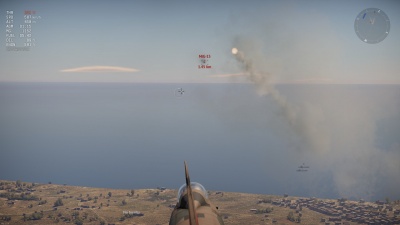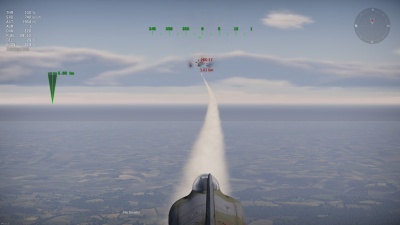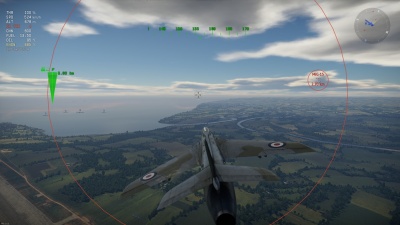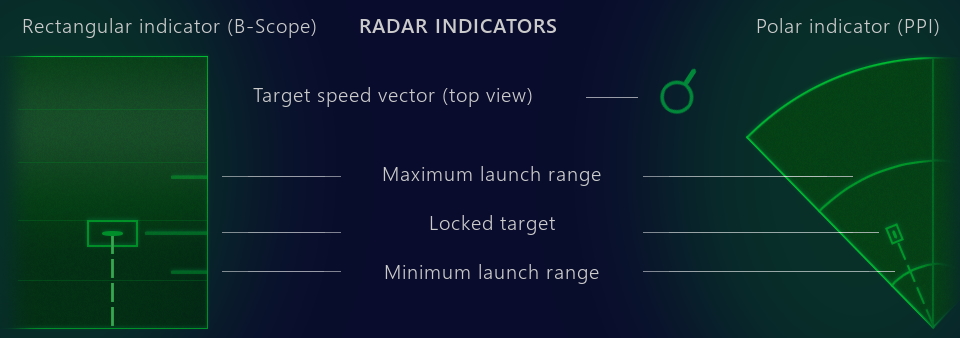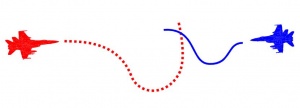Air-to-air missiles
Contents
- 1 Overview
- 2 Command guided missiles
- 3 Beam riding missiles
- 4 Infrared homing (heat-seeking) missiles (FOX-2)
- 5 Semi-Active Radar Homing (SARH) missiles (FOX-1)
- 6 Active Radar Homing (ARH) missiles (FOX-3)
- 7 Avoiding air-to-air missiles
- 8 Media
- 9 See also
- 10 External links
Overview
Air-to-air missiles were added to the game in Update 1.85; they are available to many aircraft from around the Korean War era and onwards. In-game they are a potent weapon to have at your disposal, allowing you to destroy enemy aircraft from several km away in some situations. There are currently a few categories of air-to-air missiles available to use: command guided missiles, beam riding missiles, infrared homing (heat-seeking) missiles, and semi-active and active radar homing missiles.
Rockets vs. Missiles
The thing that separates air-to-air missiles from rockets is the presence of a guidance system. When a rocket is fired it will simply fly along its trajectory until it hits something (a target or more often the ground), or self-destructs. By comparison, an air-to-air missile has an active guidance system, allowing it to fly towards and follow a target.
Command guided missiles
The most basic type of air-to-air missiles in-game are command guided. Command guided missiles are manually guided to the target by the pilot (or another crew member) of the aircraft which fired them. Once the missile was fired the pilot would watch the missile (many missiles had a flare in the tail to aid visibility) and manually guide it towards the target, using a joystick.
For PC/Keyboard players, standard control keys for this missile is W,A,S,D. Movement of the vehicle using the W,A,S,D keys is not allowed during the time of missile guidance
Command guided missile usage
In-game if a command guided missile is fired, and no further input is given, then it will act like an unguided rocket with a proximity fuse. In order to guide the missile you must set up guided weaponry controls (see below); after you have fired the missile you can then use the controls to manually guide it towards the target. Guiding a missile will usually require you to stop controlling your aircraft, as guiding the missile to its target is hard enough without also manoeuvring your aircraft at the same time, so make sure there is no one on your tail before you fire one. It takes a lot of practice to get good at using command guided missiles, however, such missiles usually have a large warhead and proximity fuse, making the job slightly easier. It can sometimes be desirable to use command guided missiles as unguided, proximity-fused rockets; such as in head-ons or if an enemy is dead in front of you (e.g. after they over-shot you).
| Unlike heat-seeking missiles, command guided missiles will not trigger a missile launch warning for the enemy player. |
Command guidance pros and cons
Pros:
- Not vulnerable to countermeasures
- Do not trigger missile warnings
- Much better manoeuvrability than beam riding missiles, and better than some heat-seekers
- Can be used as unguided proximity rockets
Cons:
- Have to stop controlling aircraft to control missile
- Can be hard to manually guide missiles
- Can be easy to dodge if the missile is spotted soon enough
Command guided missile controls
To control command guided missiles you set up axis controls for the pitch and yaw; select the relevant control from the menu and click the edit axis button, this will display various controls you can edit. The "maximum value" control is the button you want to press to increase the missile's steering angle (make the missile go up in pitch or right in yaw); and the "minimum value" control is the button you want to press to decrease the missile's steering angle (make the missile go down in pitch or left in yaw). The rest of the controls (apart from relative control, see next paragraph) can be left on default values without much thought and are present for user preference.
An important option to consider is "relative control"; this dramatically changes how you control the missile. With relative control off pressing a control key will immediately set that axis's steering value to 100% and back to 0% when the key is released. By comparison with it on pressing a control key will gradually increase / decrease the steering angle and it will remain at that value until the player changes it.
What this amounts to is that if relative control is off and the player presses the control to move the missile right, the missile will begin moving to the right, then start flying straight in whatever direction it is facing when the player releases the key. With relative control on the missile will begin moving the right and when the player releases the key the missile will keep turning to the right in an arc until the player presses the left key to move the missiles steering angle back to 0%. Personal preference will determine how you set this option, but turning relative control off can be more intuitive, as it makes correcting the missile's course quicker and easier.
| Command guided missile controls | ||
|---|---|---|
| Control name | Default Keybind (PC keyboard & mouse) |
Description |
| Yaw axis for aim weapons | ⇧ Shift+A / ⇧ Shift+D | Keys to control the yaw (side to side) movement of the missile |
| Pitch axis for aim weapons | ⇧ Shift+W / ⇧ Shift+S | Keys to control the pitch (up and down) movement of the missile |
| Fire air-to-ground missile | Space | Fire the command guided missile (they are treated as proximity fused air-to-ground missiles) |
List of command guided air-to-air missiles
| Command guided missiles | ||
|---|---|---|
| Missile | Country | Max guidance range |
| AA-20 Nord | |
8,000 m |
Beam riding missiles
Beam riding is another primitive form of missile guidance. An aircraft equipped with beam riding missiles will also carry a small radar transmitter, which projects a narrow (few degrees wide) radio beam in front of the aircraft. When the missile has launched, a receiver on the rear of the missile detects the beam from the aircraft and steers the missile to keep it within the beam. The effect of this is that the missile will fly wherever the beam is pointing.
Beam riding missile usage
In-game to use a beam riding missile, you simply fire it; the missile will then enter the beam and fly towards where the nose of your aircraft is pointing. You can gently manoeuvre the nose of your aircraft to correct the course of the missile.
Beam riding missiles have a number of disadvantages; firstly once the missile is fired you have to keep the nose of the aircraft pointing at the enemy aircraft, as the missile follows wherever the nose of your aircraft is pointing. Secondly the missile has a very low turning ability, if you move the nose of your aircraft too quickly the beam will move away from the missile quicker than the missile can correct, so the missile will fall out of the beam, at which point you lose all control of the missile; therefore you can only make gentle movements once the missile is launched. Finally, the missile becomes less accurate the further it gets away from the launching aircraft; the beam from the aircraft spreads as it moves away from the aircraft, so at long ranges the missile can still be within the beam, but off-centre (some missiles are better at staying centred within the beam than others)
| Unlike heat-seeking missiles, beam riding missiles will not trigger a missile launch warning for the enemy player. |
Beam riding pros and cons
Pros:
- Not vulnerable to countermeasures
- Do not trigger missile warnings
- Can be easier to guide than command guided missiles
- Can be used as unguided proximity rockets
Cons:
- Must keep your aircraft pointing at the target
- Bad at engaging manoeuvring targets
- Anything more than gentle corrections will make missile fall out of beam and lose tracking
- Gets less accurate with increased range
- Easy to dodge if the missile is spotted
Beam riding missile controls
To control the missile, launch it then gently correct its course by moving where the nose of your aircraft is pointing.
| Beam riding missile controls | ||
|---|---|---|
| Control name | Default Keybind (PC keyboard & mouse) |
Description |
| Fire air-to-ground missile | Space | Fire the command guided missile (they are treated as proximity fused air-to-ground missiles) |
List of beam riding air-to-air missiles
| Beam riding missiles | |||
|---|---|---|---|
| Missile | Country | Max overload | Max guidance range |
| Fireflash | |
10 G | 4,000 m |
Infrared homing (heat-seeking) missiles (FOX-2)
Infrared (IR) homing missiles, also known as heat-seeking missiles, or heat-seekers, are the most widespread type of air-to-air missile in War Thunder. Infrared homing missiles have what is known as an IR seeker mounted in the nose of the missile. The IR seeker is capable of detecting the infrared light emitted by the target; and when the missile is launched the IR seeker tracks the source of infrared light and steers the missile towards it. These missiles are commonly called "heat-seekers", as things which are hot emit large amounts of infrared light, so the missile is effectively looking for hot things to lock on to.
| Infrared homing missiles will lock on to any suitably strong infrared light source; this includes friendly aircraft (RB and SB) and the sun |
Infrared homing missile usage
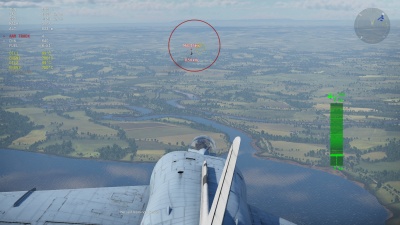
Firing infrared homing missiles in-game is a little more complicated than firing other types of weaponry. You must first turn on the IR seeker (see controls section below). Once the seeker is turned on you will see a circle (green by default) appear on your screen, the missile seeker is now cooling down to improve the performance; the length of time required for the seeker to cool-down can vary between missiles (see individual missile pages for details), but is generally a second.
Once the seeker has cooled down it will become active and the green circle will begin to flash; this will be accompanied by a "growling" noise to let you know the missile is active. You must now manoeuvre your aircraft to place the circle over the target you wish to click on to. The seeker on each missile has a maximum range at which it can lock on to a target; you will need to be within that range to get a lock. Most missiles will also require you to be in the rear aspect of your target (behind the target) so that the missile can lock onto the target's engine exhaust (see the all aspect seekers section for more information). Once a lock is achieved the green circle will turn solid red and the growling noise will change in tone, indicating a lock. Once a lock is achieved you can fire the missile, after this point the missile requires no further input and will guide itself to the target.
Once the missile is fired there is no guarantee it will hit the target. Early missiles cannot turn very tightly (about 5G), so it is possible for the enemy player to dodge the missile.
Important notes:
- If your missile locks onto the wrong target before you launch it, you can turn the seeker off then back on again to reset it and force it to find a new target (this is mainly a problem for missiles with uncaged seekers, where you cannot easily move the seeker ring off the target).
- If you are in the cockpit view there are no rings visible, you must rely purely on the growling tone to know when the missile seeker is active and locked.
- Each missile has a maximum amount of time the seeker can be powered up for before launch. If this time is exceeded the seeker will turn off and have to be turned back on again manually (see individual missile pages for details).
- Just because you have achieved a missile lock does not mean it is a good idea to fire the missile; many missiles can lock onto a target which is outside of their effective range (although within their max range), make sure you have closed to a good firing range. In addition, firing while yourself, or the enemy plane, is mid-manoeuvre, is just asking for the missile to lose its lock.
- Once a missile is fired it can lose its lock on the enemy aircraft and lock on to something else; if a friendly flies in front of your missile be prepared for the missile to start chasing them instead. Likewise, if the sun is in the background of your target, expect the missile to fly towards the sun (after all the missile is looking for infrared light, and the sun puts out way more of that than the enemy plane does).
- If there is more than one target in front of the missile's seeker then the seeker may get confused and the missile will likely fly off course and miss.
Caged vs uncaged missile seekers
Most early infrared homing missiles have what is known as a caged IR seeker prior to being launched, this means the seeker is locked facing directly forwards. This is the mode described in the section above (and the image in that section); in-game you will see a small circle, which you have to position over a target to get a lock, then hold over the target until you fire the missile.
Some more advanced missiles are capable of "uncaging" their seeker once a target has been locked. This means that once the seeker has locked onto a target it is free to move. In practice this means that once you have locked on to a target with one of these missiles you no longer have to manually keep the missile's seeker over the target to maintain a lock prior to launch, the missile will maintain its own lock and you can (within reason) manoeuvre you aircraft before firing the missile.
In-game when the seekers of these missiles are turned on you will see the normal missile seeker ring, but there will also be a larger ring present around the missile seeker ring. To lock on you still need to position the smaller ring over the target, but once a lock is achieved you only need to keep the target within the big ring to maintain a lock. The user interfaces for missiles with uncaged seekers can be seen to the right.
Uncaged seekers are a major advantage as they make maintaining a lock prior to launch much easier. They also allow you to "lead" the missiles like you would your guns, making them more likely to hit turning opponents.
Slaving the seeker to an aircraft tracking radar
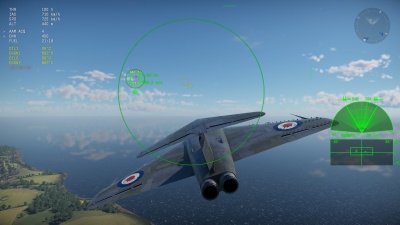
Aircraft which have tracking radars have the option of slaving the missile's IR seeker to their radar system. This means that when a target is being tracked by the radar and the missile seeker is turned on, instead of the seeker pointing directly forwards it will receive data from the radar and point at the target the radar is locked on to.
Rotorcraft with a gunner seat or ATGM tracking camera may also guide their seeker manually by hopping in the gunner seat or using the tracking camera, however it is not possible to fire the missile until the player switches back to pilot mode. It is important that the crosshair is pointing at the enemy aircraft and locked upon switching back to the pilot seat otherwise the seeker head will reset.
The benefits of slaving the IR seeker to the tracking radar are essentially the same as having an uncaged sensor; making achieving and maintaining a lock easier, as well as allowing you to "lead" the missile in some situations. A disadvantage is that opponents with RWR will become alerted by the locking of the radar, thus alerting them to the presence of a potential missile.
All aspect seekers
Most infrared homing missiles in-game are what are known as "rear-aspect" missiles, which require you to be in the rear aspect of your target (behind the target) in order for the missile to lock on. This is because early IR seekers were only sensitive enough to lock on to very hot targets, such as the exhaust of a jet engine. There are however some more advanced missiles in-game which are known as "all-aspect" missiles, these missiles have more sensitive IR seekers and better tracking systems which are able to detect other heat sources, such as those emitted from the body of the aircraft or from the plume of afterburner flame expanding out from the aircraft, allowing the missile to lock on to and engage a target from any direction. These missiles are a major upgrade other infrared homing missiles, they allow you to attack a target from any direction and are much harder to dodge.
Countermeasures
There are general techniques pilots can employ to dodge missiles (covered in a later section), however, in addition, some vehicles also have systems dedicated to defeating infrared homing missiles. These systems fall into two categories: flares and IRCM systems.
Flares
The most basic countermeasure to infrared homing missiles is the use of flares. Flares are a type of pyrotechnic which can be fired (usually in bursts) from the target aircraft when the pilot believes a heat-seeking missile has been fired at them. The flare burns extremely hot and produces a large amount of infrared light; this will often trick the IR seeker of the missile into locking on to the flares instead of the target aircraft. More modern missiles with more advanced IR seekers are less vulnerable to flares.
If a target you are locking onto deploys flares, you will often see the seeker ring move over to the flares instead of the target. If the target deploys flares after a missile has been fired, then the missile will often switch course and fly towards the flares. Some modern missiles in-game are not affected as much by flares, however, this doesn't mean the missile is completely invulnerable to countermeasures.
Infrared Counter Measures (IRCM) systems
A more advanced countermeasure to infrared-guided missiles are Infrared Counter Measures (IRCM) systems, these systems are effectively jammers for infrared missiles. There are two techniques used by these systems: older systems would have a powerful infrared light source, which was then flickered on and off; this would disrupt the missile's guidance system and cause it to fly off course. More modern systems detect the missile and shine a laser directly at it, blinding the IR seeker.
In-game, these systems make locking on to aircraft with the system activated much harder. These systems are predominantly found on helicopters, with a few planes possessing IRCM systems like the Su-25T and the Su-39.
Infrared homing missile controls
| Infrared homing missile controls | ||
|---|---|---|
| Control name | Default Keybind (PC keyboard & mouse) |
Description |
| Weapon lock | Alt+X | Toggles the missile's IR seeker on or off |
| Fire air-to-air missile | Alt+Space | Fires the air-to-air missile once a target is locked, or if IR seeker is not active it will activate the seeker. |
Infrared homing pros and cons
Pros:
- Fire and forget in nature
- Hardest type of missile to physically dodge (although this depends on the exact missile, some like the SRAAM can be extremely hard to dodge, while others are quite easy)
- Easiest missiles to use
- Can be all-aspect depending on missile
Cons:
- Vulnerable to other heat sources
- Can lock on to the sun and friendly players
- Vulnerable to flares and IRCM (generally making most IR missiles near useless against top tier helicopters)
List of infrared homing air-to-air missiles
| Infrared homing missiles | |||||
|---|---|---|---|---|---|
| Missile | Country | Max overload | All-aspect | Uncaged seeker | Radar slaving |
| 9M39 Igla | |
10.2 G | |
|
|
| AAM-3 | |
40 G | |
|
|
| AIM-9B Sidewinder | |
10 G | |
|
|
| AIM-9B FGW.2 Sidewinder | |
10 G | |
|
|
| AIM-9D Sidewinder | |
18 G | |
|
|
| AIM-9E Sidewinder | |
10 G | |
|
|
| AIM-9G Sidewinder | |
18 G | |
|
|
| AIM-9H Sidewinder | |
18 G | |
|
|
| AIM-9J Sidewinder | |
20 G | |
|
|
| AIM-9L Sidewinder | |
30 G | |
|
|
| AIM-9L/I Sidewinder | |
30 G | |
|
|
| AIM-9M Sidewinder | |
30 G | |
|
|
| AIM-9P Sidewinder | |
20 G | |
|
|
| AIM-9P4 Sidewinder | |
20 G | |
|
|
| ATAS (AIM-92) | |
13 G | |
|
|
| Firestreak | |
15 G | |
|
|
| Flz Lwf 63/80 | |
20 G | |
|
|
| MAA-1 Piranha | |
45 G | |
|
|
| Matra R530E | |
15 G | |
|
|
| Matra R550 Magic 1 | |
35 G | |
|
|
| Matra R550 Magic 2 | |
35 G | |
|
|
| Mistral | |
16 G | |
|
|
| PL-2 | |
10 G | |
|
|
| PL-5B | |
30 G | |
|
|
| PL-5C | |
30 G | |
|
|
| PL-7 | |
35 G | |
|
|
| PL-8 | |
40 G | |
|
|
| Python 3 | |
40 G | |
|
|
| R-3S | |
10 G | |
|
|
| R-13M1 | |
20 G | |
|
|
| R-23T | |
20 G | |
|
|
| R-24T | |
24 G | |
|
|
| R-27T/R-27T1 | |
35 G | |
|
|
| R-27ET/R-27ET1 | |
35 G | |
|
|
| R-60 | |
30 G | |
|
|
| R-60M/R-60MK | |
30 G | |
|
|
| R-73/R-73E | |
40 G | |
|
|
| RB24 | |
10 G | |
|
|
| RB24J | |
20 G | |
|
|
| RB 74 | |
30 G | |
|
|
| RB 74(M) | |
30 G | |
|
|
| Red Top | |
12 G | |
|
|
| Shafrir | |
11 G | |
|
|
| Shafrir 2 | |
18 G | |
|
|
| SRAAM | |
20 G | |
|
|
| TY-90 | |
20 G | |
|
|
Semi-Active Radar Homing (SARH) missiles (FOX-1)
SARH guidance is often used for medium-range and long-range air-to-air missiles, which rely on the launch aircraft to provide guidance (specifically a radar lock). SARH missiles rely on radar waves from the launch aircraft reflecting off the target, similar to beam-riding missiles. However, due to the larger boresight angles and larger radar scanning angles, these missiles offer increased performance.
SARH missile usage
- How are these missiles fired?
Since SARH missiles are capable of locking onto targets that are out of the pilot's visual range, it might be tricky for the said pilot to estimate the distance to the target. This type of armament has a specific operational range, or the launch envelope, which can be defined as the distance between minimum and maximum ranges of the missile given the present movement parameters of the player's aircraft and the target. This zone is strictly individual for every missile model and varies with technical characteristics.
The minimum launch range is affected by parameters such as:
- The commit time when the missile begins homing in on the target. For instance, for the R-3R model, this is equal to 0.5 seconds, while for the AIM-7D/E – approximately 2 seconds.
- The post-launch time required to arm the fuse.
- The turn rate of each particular model of missile. For example, if an opponent is flying directly towards or away from the player's aircraft, the manoeuvring time window of the missile will be minimal, while if the movement trajectory of the opponent's aircraft is perpendicular to the player's, the time window will be maximal.
In a similar vein, each missile has a maximum launch range, which depends on:
- The aerodynamics, motor thrust, and firing duration of the missile.
- The flight altitude of the player's aircraft – the higher its value, the greater the missile's flight range.
- The flight altitude of the opponent's aircraft – correspondingly, the higher up in the sky they are, the shorter the flight range of your missiles.
- The speed of the player's and the opponent's aircraft, as well as the angle at which the opponent's aircraft is moving with respect to the player – if they are flying away from you, the maximum launch range is severely reduced.
The armament control system calculates all the aforementioned parameters and helps the player identify the potential launch envelope – the minimum and maximum launch ranges will appear as small marks by the right-hand side of the indicator if the B-Scope (rectangular coordinate system) is used, and as arcs if the radar uses the polar system. Check Airborne radars for more information, because not all planes have such a feature.
Moreover, the pilot has the indicator of the target's velocity vector at their disposal. You will find it right under the square marking the locked-on target. If the target's velocity vector changes laterally, the side component will reveal their speed, and the vertical component – the direction in which they are moving with respect to the player (down and up are towards and away correspondingly).
Don't expect an "intelligent" armament to do all the hard work for you – if your target changes speed or direction after you have fired the missile, it may not hit the target. Besides, when tracking the target, the missile may be confused by ground clutter. Such a scenario is possible if you are radiating a signal down on the target (in this case, the opponent is situated below the horizon line). This causes the radio waves to bounce off the ground, that might prevent the seeker from tracking down the target. Additionally, there's even a higher risk of this phenomenon when firing a missile at a low altitude, because the side lobes of your aircraft radar and the missile seeker receive all-ways signals reflected off the Earth surface, which may result in the missile losing its target. To ensure you don't run into these problems, lock onto the target and launch your SARH missiles when you are positioned below them.
- How does the SARH home in on its target?
Unlike IR guided missiles, missiles with a semi-active radar seeker lock onto and track their target and maintain range or speed tracking. Thus, the missile will never become distracted by other targets within the reflected radio-signal acquisition zone while simultaneously ignoring some of the emissions reflected back from ground and water surfaces. The seeker is equally operable whether pulse or continuous wave signal is used. However, different missiles have different subtle aspects depending on targeting mode, and it's crucial to study them in advance if you wish to make the best use of your SARH missiles.
When bombarding an opponent with pulsed emissions, the guided warhead will home in on the target according to distance – the R-3Rs, Matra R.530 and some others employ this approach. This mode allows the pilot to mark the desired target and fire a missile at it while ignoring other possible targets and parasitic signal reflections off the Earth surface that are reflected at ranges different from the range to the target the missile is locked on. In addition to this, you can lock onto the target of choice before launching the missile. When deploying SARH warheads in pulsed mode, it's important to remember that locking onto a target positioned below the horizon line or at low altitudes may cause issues. For a perfect lock-on, target opponents at medium and high altitudes – and only if they are level with you or above you. If the distance between you and the target is less than the flight altitude of your aircraft, you can totally neglect the emission bouncing off the ground – under these conditions, the missile is guaranteed to lock onto and track the target.
Specific missiles, like the American AIM-7D/E, track the target based on its radial speed by using the Doppler effect as they are guided by a continuous or pulse-Doppler radar signal. In this particular instance, the seeker ignores any targets and signals reflected off the ground surface in the set direction with different speed values. The cons of such technology include the impossibility for the seeker to lock onto a target before launch, issues locking onto a target travelling perpendicular to the movement trajectory of your aircraft, and the reduction of the lock-on range when pursuing fleeing targets. In order to lock onto a target, the missile must travel at least 1–2 km away from the carrier, which renders them useless in a dogfight. These missiles are most effective against opponents moving towards you, as well as against fleeing targets travelling at medium or high altitudes – in this case, the seeker will never misidentify any signal reflected off the Earth surface as objects travelling at the target's speed.
SARH guidance: Pros and Cons
Pros:
- Radar guidance
- All-aspect capability
- Immune to flares and helicopter IRCM
- Usually boasts medium or long range
Cons:
- IR missiles generally accelerate faster and are initially more manoeuvrable in short ranged scenarios
- Requires you to maintain radar lock on your target for the entire duration of flight
- Vehicles with a Radar Warning Receiver (RWR) can tell when you are locked on to them
- Performance significantly depends on the potency of the launching aircraft’s radar
SARH missile controls
| Infrared homing missile controls | ||
|---|---|---|
| Control name | Default Keybind (PC keyboard & mouse) |
Description |
| Lock radar target on | Alt+F | Locks onto a target with the aircraft's tracking radar. |
| Weapon lock | Alt+X | Toggles the missile's seeker on or off. |
| Fire air-to-air missile | Alt+Space | Fires the air-to-air missile once a target is locked, or if seeker is not active it will activate the seeker. |
List of SARH air-to-air missiles
| SARH missiles | |||
|---|---|---|---|
| Missile | Country | Max overload | Launch range |
| AIM-7C Sparrow | |
15 G | 25 km |
| AIM-7D Sparrow | |
15 G | 45 km |
| AIM-7E Sparrow | |
25 G | 50 km |
| AIM-7E-2 Sparrow | |
25 G | 50 km |
| AIM-7F Sparrow | |
25 G | 100 km |
| AIM-7M Sparrow | |
25 G | 100 km |
| AIM-9C Sidewinder | |
18 G | 18 km |
| Aspide-1A | |
25 G | 80 km |
| Matra R511 | |
12 G | 8 km |
| Matra R530 | |
15 G | 18 km |
| Matra Super 530D | |
30 G | 40 km |
| Matra Super 530F | |
20 G | 40 km |
| R-3R | |
10 G | 9 km |
| R-23R | |
20 G | 27 km |
| R-24R | |
24 G | 50 km |
| R-27R/R-27R1 | |
35 G | 55 km |
| R-27ER/R-27ER1 | |
35 G | 100 km |
| RB71 | |
25 G | 50 km |
| Sedjil | |
15 G | 135 km |
| Skyflash | |
25 G | 50 km |
| Skyflash SuperTEMP | |
25 G | 50 km |
Active Radar Homing (ARH) missiles (FOX-3)
Active radar homing (ARH) missiles have a radar emitter built in so that they don't have to rely on target illumination by the aircraft that fired it, making them fire-and-forget weapons. Unfortunately, this is only true to an extent: ARH mode is only available when the missile is coming close to the target, as the range of the built-in radar is limited by its size, which needs to fit inside the compact missile. During the first stage of the flight, the missile has to either rely on inertial guidance, act like a SARH missile, or be course-corrected by Datalink from the aircraft.
List of ARH air-to-air missiles
| ARH missiles | ||||
|---|---|---|---|---|
| Missile | Country | Max overload | Launch range | ARH range |
| AAM-4 | |
32 G | 100 km | 16 km |
| AIM-54A Phoenix | |
17 G | 150 km | 16 km |
| AIM-54C Phoenix | |
17 G | 150 km | 16 km |
| AIM-120A | |
35 G | 80 km | 16 km |
| AIM-120B | |
35 G | 80 km | 16 km |
| Derby | |
40 G | 80 km | 16 km |
| Fakour-90 | |
15 G | 150 km | 16 km |
| MICA-EM | |
50 G | 50 km | 16 km |
| PL-12 | |
38 G | 80 km | 16 km |
| R-77/RVV-AE | |
50 G | 80 km | 16 km |
| R-Darter | 40 G | 80 km | 16 km | |
| RB 99 | |
35 G | 80 km | 16 km |
Avoiding air-to-air missiles
There are various techniques you can use to avoid the different types of air-to-air missiles. As a general rule though situational awareness is absolutely key, you should be looking out to see if any aircraft around you could have air-to-air missiles, and judging what type they are likely to have. If an enemy is on your tail keep looking to see if a missile is launched. You may not get a warning (depending on missile type) and even if you do it may be too late.
Avoiding command guided missiles
Begin manoeuvring to make it hard for the enemy player to hit you. If one is fired at you in a head-on, then abandon the head-on immediately, if you don't the proximity fuse will get you.
Avoiding beam riding missiles
Any manoeuvre pulling more than a few G's will likely cause the missile to fall out of the beam from the chasing aircraft, at which point the missile poses little threat. Again if one is fired in a head-on then abandon immediately and pull off to the side.
Avoiding heat-seeking missiles
How you best avoiding heat-seeking missiles depends largely on what missile was fired at you; it is recommended to familiarise yourself with what missiles different planes carry and what the characteristics of each are. For early missiles, you should be able to turn tighter than the missile and make it lose its lock that way. For missiles which you can't simply throw off with a hard turn your options are more limited, you can try pulling a sort of barrel roll manoeuvre, the combination of turning hard and rolling can sometimes throw the missile off. Depending on how far away it was launched, it may be possible to outrun the missile, making gentle side-to-side manoeuvres to maximise the missile's flight path while maintaining speed. A final option is to manoeuvre your aircraft so that it is directly between the missile and the sun, causing the missile to lock onto the sun; although this is rarely possible in battle situations, this can be done pre-emptively (i.e. fly towards the sun when you spot an enemy with air-to-air missiles on your tail).
If you have flares deploy them and turn sharply so you get away from the missile seekers field of view. Advanced heat-seeking missiles can have IRCCM (InfraRed Counter-Counter-Measures) which are not easily confused by flares.
Avoiding radar-guided missiles
Like IR-guided missiles, the best method of dodging radar-guided missiles largely depends on the missile. Early missiles can be dodged kinetically, by turning and rolling vigorously to throw off the missile's lead. In the case of a more capable missile, it may be easier to break the radar lock from the opposing aircraft instead - this can be achieved by deploying chaff, and also notching against pulse-Doppler radars. This can also apply against active radar-homing missiles, breaking the radar lock of the missile itself rather than the aircraft's.
In a low altitude head-on situation, the radar in question will commonly be in pulse-Doppler mode, so your best defence is to point the nose down, which will cause the incoming missile to calculate the interception point below the ground surface and thus make it crash. This will however not work if the enemy is at a higher altitude than you, because the interception point will be still above the ground. This at the same time means that if you are attacking in such a situation loft the missile up so it will have more probability in hitting the target, unless you have to evade yourself. Flying particularly close to the ground can also cause missiles to lose track of their target signal within the ground clutter, causing them to harmlessly veer off course.
At high altitudes, radars in simple pulse mode become more prevalent, against which notching is not effective. If you see the missile early enough, a side-to-side manoeuvre can be utilised, which will burn energy from the missile, slowing it down and also causing it to turn very hard to intercept, after which it will be unable to manoeuvre hard enough to hit after you change direction.
Media
- Videos
See also
External links
- Devblogs
- [Devblog] Improved heat signatures for jet engines
- [Development] SARH Air-to-Air Missiles
- [Development] Air-to-air Missiles
- Wikipedia


